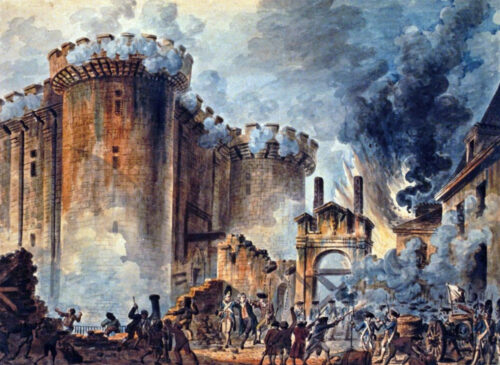Storming the Fortress

We have another of the month-long festivals to observe today, one of five this July alone. It has a curious bridge to another one on the list, which is a tribute to mental instability. It is called up specifically on this date among the 31 other options since it celebrates something specific on this one: the Storming of the Bastille.
We ran across this one before it became the July commemoration of our Franco-American heritage. This one follows our own Independence Day on the 4th, and so it has a certain historical context that yanks us more than two centuries in time. Our English-speaking world uses it as a common term for the National Holiday in France. They naturally have a name en francais for the celebration: “Fête nationale française” is the one they like and we are happy to join them on what is legally known as le 14 juillet. It is the anniversary of the armed assault on the fortress of the Bastille, a major event in the French Revolution against the monarchy that once ruled their nation.
Sound familiar? We just devoted the better part of a week to ours, so it seems appropriate to recognize the one that transformed a Europe that is once again in turmoil. During our 4th of July, there were widespread riots over the killing of a young immigrant man who disobeyed some laws that were formerly treated with strict enforcement. We recently did the same thing here over a killing in Minneapolis, so the echoes of past and present are loud enough to hear across the aves in both directions.
In fact, some have observed that Charles Martel’s successful defense of what the Romans knew as “Gaul” against a mass immigration has been overturned after more than a thousand years. The assault on the Bastille is much closer to us, and is the one we join our French brothers and sisters today. “Bastille Day” occurred on this date in 1789, and celebrations will occur throughout the Francophone world. There was a lot of that tradition that remains in Africa and the far reaches of the Pacific.
We honor it, though there is a certain amount of nuance to the day of remembrance. The name of the place is just one of them. The iconic moment was spurred by fears that King Louis XVI was about to arrest the newly-elected members of the National Assembly. A crowd of Parisians surrounded the old Bastille Saint-Antoine. It had used as the King’s state prison for more than a century, and was symbolic of his power as monarch.
It was not exactly the symbol of oppression we popularly recall. On this day in 1789, the inmates of the prison numbered only seven. Four of them were common counterfeiters, two men accused of mental deficiencies and a single nobleman confined at the request of his family.
Regardless of the reality, the prison became symbolic of the Monarch’s historical power, and this day of popular intervention became the one that celebrates the liberation of a nation. One could equally construct a narrative that the place was too expensive to run and maintain, and there were in fact plans to rip it down and establish a public square. But that version would not support the triumph of Revolution, so like the French we will observe the original spirit of rebellion.
The actual story is filled with the nuance thing. Louis XVI was an impetuous monarch whose Queen, Marie Antoinette, remains most famous today for her ironic treatment of a disastrous shortage of bread in French markets: “Let them eat cake!”
Louis was almost the last of the notable prisoners in his Bastille, and his Queen joined him neck-down on the Guillotine only weeks after the Monarch’s head was disassociated from his torso. On the actual Day, Bernard-Rene de Launay, Governor of the Bastille, watch with alarm as a large mob of revolutionaries surrounded the prison. They demanded his surrender, and de Launay invited them in to negotiate a settlement.
ddddd.
Guidance from the oppressive King on how to proceed was not forthcoming. The revolutionaries outside were told the delegates had been imprisoned, and a group of them scaled an outer wall and lowered a drawbridge allowing the crowd to surge inside. The Governor of the Bastille found himself with no alternative but to order his defending troops to shoot at the intruders. Nearly one hundred of them were killed and dozens more wounded. The Governor only lost a single soldier in the exchange, but the violence provoked a detachment of the mutinous French Guards to intervene on behalf of the Revolutionaries and the Revolution.
The Governor lacked sufficient supplies to support his defense, and waved the white flag of surrender.
What had started as a pretty good day for him did not work out that way. Taken prisoner, he was marched to City Hall where an angry crowd of Parisians wrested him from his escort. He was killed before his head was chopped off, mounted on a pike, and paraded around the city. That was the impetus for the murder of other Royal troops, a bloody foreshadowing of the rivers of red that would flow in the interest of freedom in the torrent of the Revolution to come.
We may be seeing the beginning of something similar in terms of tectonic social change. But let us remember the popular story on the day of anniversary. Today, Bastille Day is commemorated with food and drink and memorable stories. And fireworks.
Let us give a thought this day to another time in the tangled affairs of our species. There is change to celebrate. And to recall the ironic triumph of a Queen’s admonition to her people: We now all have the opportunity to eat the cake. In fact, there is a new movement that suggests we can eat as much of it as we desire!
Copyright 2023 Vic Socotra
www.vicsocotra.com
